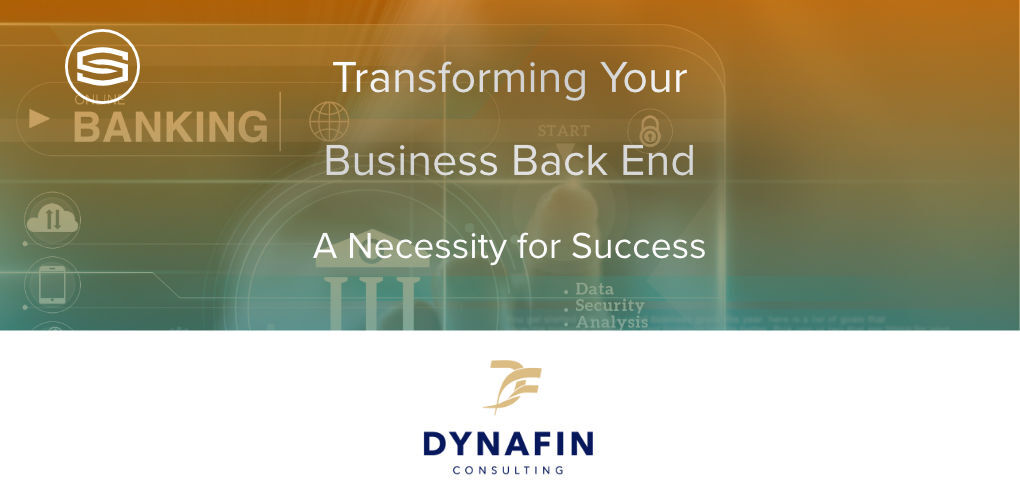
Insights & Opinions
Transforming Your Business Back End: A Necessity for Success
Thu, 21 Sep 2023


In the ever-changing financial services industry landscape, success hinges on more than just a polished front end. Economic shifts, technological advancements, and evolving customer demands have forced Financial Institutions to adapt quickly, making the digitisation of the backend an urgent priority.
In this article, DynaFin explores why this shift is no longer optional, outlines key challenges, and offers a roadmap for your business to embark on this transformative journey.
Why Back End Digitisation is Crucial
Over the past decade, financial institutions have encountered unprecedented challenges. Economic downturns, financial crises, and the global pandemic have accelerated the need for transformation. Organisations must embrace new technologies that enhance efficiency, elevate customer experiences, foster innovation, and meet rising customer expectations to remain competitive and relevant.
Traditionally, customer-facing applications were the focus. However, one of the most pressing challenges today is the digitalisation of the back end, often powered by legacy systems dating back decades. This shift is no longer a luxury but an imperative for various reasons.
Future-Proofing: Investing in modern back-end systems ensures that your business remains agile and adaptable in the face of future technological advancements. It positions you to use emerging technologies like artificial intelligence, machine learning, and the Internet of Things.
The Looming Talent Shortage and Legacy Systems: Another compelling reason for back-end digitisation is the imminent talent shortage. Many legacy systems rely on outdated technologies, and the experts who maintain them are approaching retirement. New talent is less inclined to work in such an outdated IT environment, exacerbating the challenge of system maintenance.
Enhanced Customer Experience: Modern back-end technology enables advanced process automation, which is crucial for efficiently handling high volumes while minimising errors. This directly translates to improved customer experience.
New Lines of Business: A robust digital back-end must enable new engagement models with digital ecosystems, which could lead to entirely new lines of business (LOBs), such as becoming data asset custodians and managing secure credentials.
Cost Optimization: While there is an initial investment in replacing legacy systems, the long-term cost savings can be substantial. Modern systems are typically more efficient, require less maintenance, and reduce the risk of costly downtime.
Real-Time Data Access & Data Analytics: Fully integrated and digitalised back-end systems provide real-time data access, empowering organisations to make agile and informed decisions. This is essential for optimising operations and delivering highly personalised products and services. In today's data-driven landscape, advanced data analytics is vital to maintaining a competitive edge and uncovering new business opportunities.
Scalability: As business grows, legacy systems may need help to scale with increasing demands. Modern back-end systems are often designed with scalability, allowing your business to expand without significant disruptions.
Key Challenges
Financial Institutions committed to embarking on back-end digitisation know this comes with its own set of challenges. Strong C-level and Advisory Board buy-in is crucial before launching the transformation program.
Upfront Costs: Establishing a digital infrastructure incurs significant initial expenses, including development costs, tool procurement, and training programs.
Security Concerns: In today's digital landscape, cyber threats are ever-present, necessitating ongoing investment in data security infrastructure. Top priorities are ensuring the security of sensitive data, protecting against cyber threats, and maintaining compliance with regulations.
Phased Approach & Integration challenges: One of the most significant challenges is the definition of the Migration Strategy, which is most often a phased approach due to the amplitude and complexity of the digitisation program. This approach implies integrating new digital components with existing legacy systems. These systems often use outdated technology and may need to be more easily compatible with modern digital solutions.
Data Migration Complexity: Transferring data from legacy systems to the new digital environment can be tricky. Ensuring data accuracy, consistency, and security during migration is crucial.
Resource Intensity: Adequate allocation of human resources, both in terms of skilled staff and time, is essential. Back-end IT system transformation can strain an organisation for several years, demanding resources for ongoing operations and the transition.
Make a Success of Your Back-End Digitisation Project
Back-end digitisation projects are complex and lengthy, with multiple components and phases. Keeping the program on track and within scope can be challenging. Before embarking on a back-end digitisation project, financial institutions should take several crucial steps to increase the multi-year program's success factor.
Define Clear Objectives: Establish specific, measurable, achievable, relevant, and time-bound (SMART) objectives. Create a multi-year roadmap to success.
Conduct a Needs Assessment: Perform a thorough needs assessment of your existing back-end systems and processes. Consider leveraging tools like Process Mining for data-driven insights.
Allocate Resources: Determine the financial, human, and technology resources necessary for the project. Ensure adequate funding and staffing throughout its lifecycle.
Choose the Right Technology: Research, select, or develop technologies and tools that align with your project's goals. Consider scalability, compatibility, and security.
Implement Effective Change Management: Develop and communicate a well-designed change strategy throughout the organisation. Provide extensive training and update documentation as necessary.
Embrace the Challenge
In conclusion, digitising the back end is no longer a luxury; it's necessary to stay competitive and relevant in today's business landscape. Companies must provide 24/7 personalised products and services supported by high-quality operational processes. Moreover, the looming risk of an IT workforce shortage underscores the urgency of this transformation.
Despite the challenges, back-end digitisation projects offer numerous benefits, including increased efficiency, improved security, enhanced customer experiences, and the ability to leverage data-driven insights. Addressing these challenges with careful planning, strategic execution, and ongoing management is essential for a successful digitisation journey.
While the challenges are real, they are surmountable. With several clients, DynaFin has successfully navigated the path to a digitised back end, unlocking new growth opportunities, fostering innovation, and ensuring long-term success.
Embrace this challenge, and your business will thrive in the digital age.


